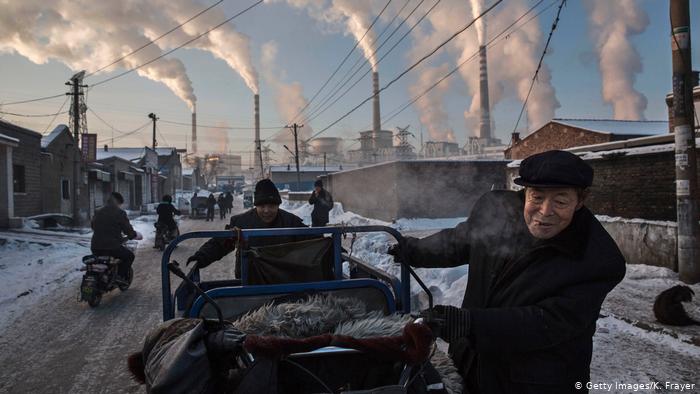Can China meet its ambitious decarbonization goals?
When the world's largest emitter set an ambitious 2060 carbon neutrality target at the UN in September, it set off a chorus of hope that global heating might be kept below catastrophic levels.
"We aim to have CO2 emissions peak before 2030 and achieve carbon neutrality before 2060," China's President Xi Jinping told the UN General Assembly in September. "COVID-19 reminds us that humankind should launch a green revolution," he added.
Given that global emissions are still rising — despite the pandemic-related slowdown — and in view of the inadequacy of the Paris climate pledges, China's announcement was widely welcomed as the most important commitment since the 2015 Paris agreement in the push to carbon neutrality by mid-century.
"It's like steroids in the move to decarbonization," said Niklas Hagelberg, coordinator of the Climate Change Program at the United Nations Environment Program, of the pledge from the world's largest carbon emitter.
With China accounting for 28% of global CO2 emissions, its carbon neutral pledge is fundamental to achieving worldwide net-zero emissions. Even without any further commitments from other countries, global heating could now be limited to around 2.35 degrees Celsius (4.23 degrees Fahrenheit) by 2100, which is 0.25 C lower than the expected rise, according to Hector Pollitt, chief economist at Cambridge Econometrics, a UK-based economic analysis firm.
In the wake of Beijing's commitment, neighboring countries followed suit, with Japan committing to net-zero greenhouse gas (GHG) emissions and South Korea to carbon neutrality by 2050 in the ensuing weeks — the three Asian economies together accounted for one-third of all global carbon emissions in 2018, according to Greenpeace.
Factoring in these new commitments, Pollitt calculates that warming could be kept to around 2 degrees by century's end — the upper limit of the Paris agreement.
Now, the climate community is waiting expectantly for the Chinese government to consolidate its commitment in its latest five-year plan, which is expected to be announced in early April.
Is the pledge unexpected?
While many countries were due to enhance their Paris pledges in 2020, few expected that China, with one of the world's fastest-growing economies, would commit to carbon neutrality in such a relatively short time frame.
"It's fair to say, it's pretty ambitious," said Pollitt, especially with China's emissions rising 2% in 2019 alone. "But it's necessary if global targets are to be met," he added.
Christine Loh, chief development strategist at the Institute for the Environment at Hong Kong University of Science and Technology, said the decarbonization target "did not come out of the blue."
Rather, it confirms China's paradigm shift from polluted "factory of the world" to clean, green producer of homegrown high-tech goods, and the world's biggest market for electric vehicles.
"Climate change has been important for a very long time in China," the former Hong Kong legislator said of Beijing's central role in creating global climate targets over the last decade, including at Paris.
Long-time chief climate negotiator Xie Zhenhua, whom Loh describes as the "Al Gore of China," argued strongly for the nation's "right to emit" as a developing country back at the failed Copenhagen COP15. Since then, however, Xie has increased China's ambition and closely collaborated with key Western climate negotiators like Todd Stern, the US special envoy for climate change under President Barack Obama, on the landmark Paris climate deal in 2015.
"Obama was able to work with China," and despite their differences on trade and human rights, they were able to make Paris a reality, said Loh.
Underlining China's new climate commitment is the reinstatement of Xie as the nation's special climate envoy in 2021 — the 71-year-old had left the position in 2019. China's climate czar has also worked closely with his counterpart in the new US administration, John Kerry.
Emissions peaking too late?
Perhaps most unexpected is the promise to reach peak emissions before 2030. "Without China, the rest of the world will struggle to peak," said Pollitt.
UNEP's Niklas Hagelberg fears this tipping point will come too late if the world is to achieve a 50% emissions cut by 2030, a fundamental target on the road to 2050 decarbonization.
That means China's emissions will have to begin falling by 2025, otherwise, "it won't be sufficient to achieve carbon neutrality by 2050 or '60," he said.
Yet Hagelberg believes this could be possible if China shows the political will to rapidly shift from fossil fuels to renewable energy. According to Pollitt, carbon neutrality by 2060 requires that no new coal power plants are built.
Can China get off coal?
With half of China's energy-related CO2 emissions generated by electricity production — nearly 15% of all energy-related carbon emitted globally — and 57% of China's energy coming from coal, transitioning from the fossil fuel will take extraordinary ambition.
In the lead-up to China's 2021-2025 five-year plan, the nation's electricity industry has been lobbying to build hundreds of new coal-fired power plants, with Hagelberg noting that 300 GW of of coal-fired power plants are in the pipeline.
But coal's future is increasingly untenable as the cost of renewables plummet and China itself seeks to confirm its dominance in the burgeoning solar power sector — HSBC forecasts that annual solar installations could rise to 85 GW over the next five years. By comparison, only 30 GW went online in 2019.
"The incredibly fast drop in prices for renewables will increase confidence to increase ambition," said Hagelberg.
A study published in Nature last May showed if renewables continue their downward price trajectory, they could provide 62% of China's electricity by 2030.


With Beijing having shown the political will to tackle its severe pollution crisis in recent years, a rapid shift away from coal is possible, Hagelberg believes. Even if new coal-fired power stations are built, old plants may be decommissioned to offset this increase.
"It's going to have to happen if they're going to meet their targets," he said.
Benefits of rapid decarbonization
Given the scale of China's 2060 pledge, Christine Loh believes that China has not only been planning for a decarbonization revolution, but that it also fears the impact of climate change, including severe flooding. "It believes in the science," she said.
Meanwhile, the massive investments required to achieve decarbonization could boost China's GDP by up to 5% by the end of this decade, and 1-2% in the long run due to the reduction in fossil fuel imports (including oil, consumption of which has tripled in the last decade), according to Cambridge Econometrics modelling.
But with around 5 million people in China employed in the coal sector alone, job losses remain a problem in the short term. Further research by Cambridge Econometrics shows, however, that the massive infrastructure building that will underpin a clean energy transformation will ultimately create as many jobs as are lost by 2060.
China's renewable investments would not only slash CO2 emissions and lower the price of clean energy, but could create what Pollitt calls a positive "spillover" effect globally. The climate community will be closely monitoring the details of China's commitment in the upcoming five-year plan, due out in April.
This article appeared on DW online at https://www.dw.com/en/can-china-meet-its-ambitious-decarbonization-goals/a-56644449



